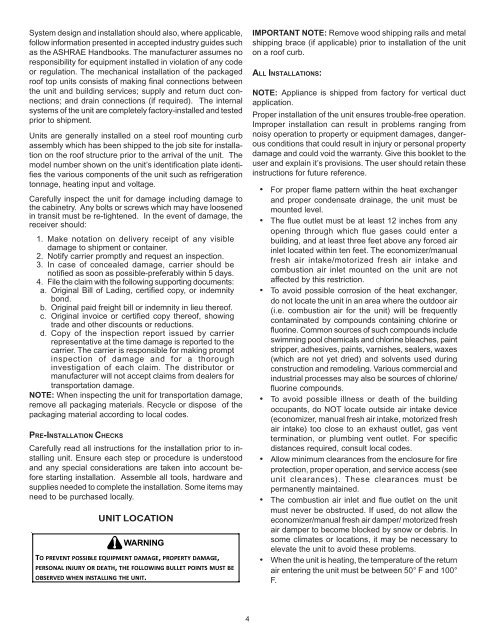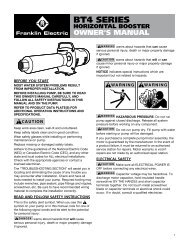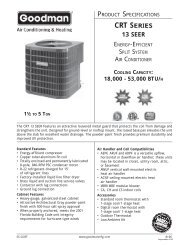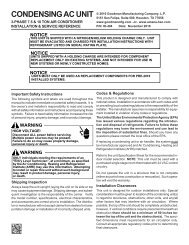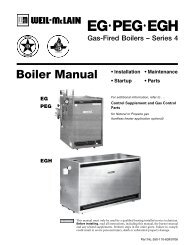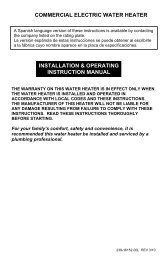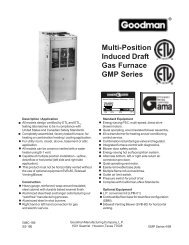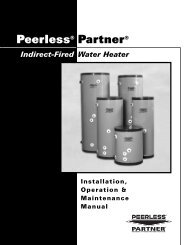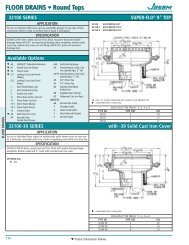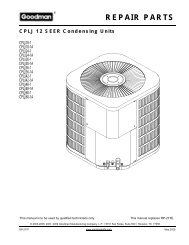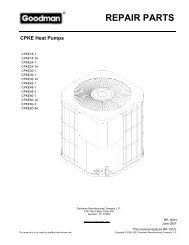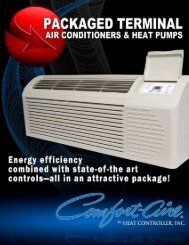7.5 TON - 12.5 TON PACKAGE GAS SERIES CPG SERIES - Goodman
7.5 TON - 12.5 TON PACKAGE GAS SERIES CPG SERIES - Goodman
7.5 TON - 12.5 TON PACKAGE GAS SERIES CPG SERIES - Goodman
Create successful ePaper yourself
Turn your PDF publications into a flip-book with our unique Google optimized e-Paper software.
System design and installation should also, where applicable,<br />
follow information presented in accepted industry guides such<br />
as the ASHRAE Handbooks. The manufacturer assumes no<br />
responsibility for equipment installed in violation of any code<br />
or regulation. The mechanical installation of the packaged<br />
roof top units consists of making final connections between<br />
the unit and building services; supply and return duct connections;<br />
and drain connections (if required). The internal<br />
systems of the unit are completely factory-installed and tested<br />
prior to shipment.<br />
Units are generally installed on a steel roof mounting curb<br />
assembly which has been shipped to the job site for installation<br />
on the roof structure prior to the arrival of the unit. The<br />
model number shown on the unit’s identification plate identifies<br />
the various components of the unit such as refrigeration<br />
tonnage, heating input and voltage.<br />
Carefully inspect the unit for damage including damage to<br />
the cabinetry. Any bolts or screws which may have loosened<br />
in transit must be re-tightened. In the event of damage, the<br />
receiver should:<br />
1. Make notation on delivery receipt of any visible<br />
damage to shipment or container.<br />
2. Notify carrier promptly and request an inspection.<br />
3. In case of concealed damage, carrier should be<br />
notified as soon as possible-preferably within 5 days.<br />
4. File the claim with the following supporting documents:<br />
a. Original Bill of Lading, certified copy, or indemnity<br />
bond.<br />
b. Original paid freight bill or indemnity in lieu thereof.<br />
c. Original invoice or certified copy thereof, showing<br />
trade and other discounts or reductions.<br />
d. Copy of the inspection report issued by carrier<br />
representative at the time damage is reported to the<br />
carrier. The carrier is responsible for making prompt<br />
inspection of damage and for a thorough<br />
investigation of each claim. The distributor or<br />
manufacturer will not accept claims from dealers for<br />
transportation damage.<br />
NOTE: When inspecting the unit for transportation damage,<br />
remove all packaging materials. Recycle or dispose of the<br />
packaging material according to local codes.<br />
PRE-INSTALLATION CHECKS<br />
Carefully read all instructions for the installation prior to installing<br />
unit. Ensure each step or procedure is understood<br />
and any special considerations are taken into account before<br />
starting installation. Assemble all tools, hardware and<br />
supplies needed to complete the installation. Some items may<br />
need to be purchased locally.<br />
UNIT LOCATION<br />
WARNING<br />
TO PREVENT POSSIBLE EQUIPMENT DAMAGE, PROPERTY DAMAGE,<br />
PERSONAL INJURY OR DEATH, THE FOLLOWING BULLET POINTS MUST BE<br />
OBSERVED WHEN INSTALLING THE UNIT.<br />
IMPORTANT NOTE: Remove wood shipping rails and metal<br />
shipping brace (if applicable) prior to installation of the unit<br />
on a roof curb.<br />
ALL INSTALLATIONS:<br />
NOTE: Appliance is shipped from factory for vertical duct<br />
application.<br />
Proper installation of the unit ensures trouble-free operation.<br />
Improper installation can result in problems ranging from<br />
noisy operation to property or equipment damages, dangerous<br />
conditions that could result in injury or personal property<br />
damage and could void the warranty. Give this booklet to the<br />
user and explain it’s provisions. The user should retain these<br />
instructions for future reference.<br />
• For proper flame pattern within the heat exchanger<br />
and proper condensate drainage, the unit must be<br />
mounted level.<br />
• The flue outlet must be at least 12 inches from any<br />
opening through which flue gases could enter a<br />
building, and at least three feet above any forced air<br />
inlet located within ten feet. The economizer/manual<br />
fresh air intake/motorized fresh air intake and<br />
combustion air inlet mounted on the unit are not<br />
affected by this restriction.<br />
• To avoid possible corrosion of the heat exchanger,<br />
do not locate the unit in an area where the outdoor air<br />
(i.e. combustion air for the unit) will be frequently<br />
contaminated by compounds containing chlorine or<br />
fluorine. Common sources of such compounds include<br />
swimming pool chemicals and chlorine bleaches, paint<br />
stripper, adhesives, paints, varnishes, sealers, waxes<br />
(which are not yet dried) and solvents used during<br />
construction and remodeling. Various commercial and<br />
industrial processes may also be sources of chlorine/<br />
fluorine compounds.<br />
• To avoid possible illness or death of the building<br />
occupants, do NOT locate outside air intake device<br />
(economizer, manual fresh air intake, motorized fresh<br />
air intake) too close to an exhaust outlet, gas vent<br />
termination, or plumbing vent outlet. For specific<br />
distances required, consult local codes.<br />
• Allow minimum clearances from the enclosure for fire<br />
protection, proper operation, and service access (see<br />
unit clearances). These clearances must be<br />
permanently maintained.<br />
• The combustion air inlet and flue outlet on the unit<br />
must never be obstructed. If used, do not allow the<br />
economizer/manual fresh air damper/ motorized fresh<br />
air damper to become blocked by snow or debris. In<br />
some climates or locations, it may be necessary to<br />
elevate the unit to avoid these problems.<br />
• When the unit is heating, the temperature of the return<br />
air entering the unit must be between 50° F and 100°<br />
F.<br />
4


